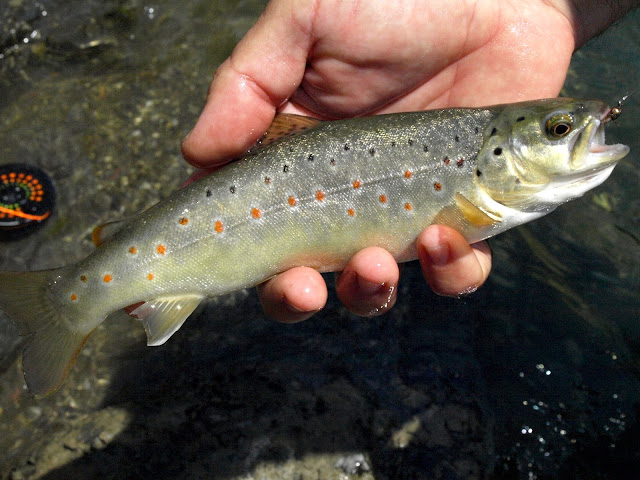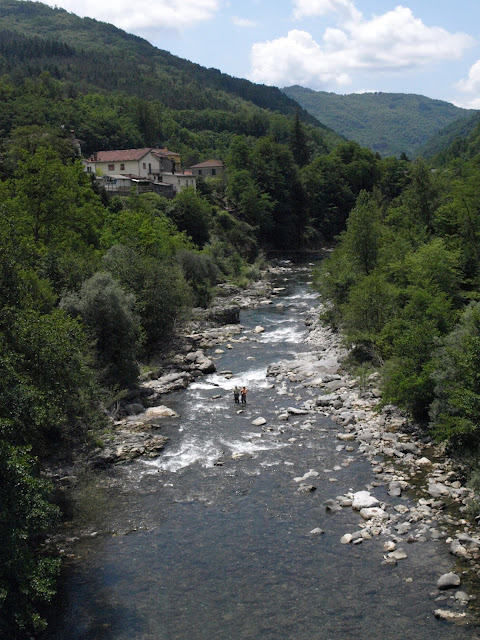River Lima, Tuscany, Italy
The Italian Job
Trout Under the Tuscan Sun
As a popular
tourist destination the central Italian region of Tuscany needs no
introduction. It offers stunning landscapes, simple yet delicious traditional
cuisine, fine Chianti and Montepulciano wines and rich history from the
Etruscans, to the Romans, to the Renaissance. The cities of Florence, Siena and
Pisa are all wonderful mirrors into the past, showcasing impressive
architecture and fine art masterpieces, with narrow cobble-stoned alleys that
exude an old fashioned intimacy. Many well known scientific and artistic
luminaries hail from the region, including Michelangelo, Galileo Galilei, Dante,
Botticelli and Machiavelli. Michelangelo’s David,
the marble masterpiece of Renaissance sculpture housed in the Accademia Gallery
in Florence, is particularly impressive and worth a visit. And if all this isn’t
enough, the region offers some pretty fine flyfishing for trout too.
The most well
known flyfishing rivers in Tuscany are the Tevere (also known as the Tiber), the
Lima and the Sieve. All are considered excellent for dry fly fishing given the
rich presence of caddis and mayflies. I was told the Tevere, Italy’s third
largest river which eventually flows through Rome many miles downstream, is
traditionally considered the premier flyfishing river in the region for both
trout and European grayling. Unfortunately a dam wall high up the river has recently
burst and flooded the valley, devastating the river habitat. Trout have been
restocked to replenish the population and the locals are hopeful the Tevere
will soon be restored to its former glory. The Lima is viewed as the most
technical to fish due its large size and powerful currents, and it’s on this
river that locally based members of the Italian National Fly Fishing team
practice their skills and national qualifying events are regularly held. The
Sieve is only a 40 minute drive from Florence and convenient for those with
limited time to explore further afield. Situated close to the capital of
Tuscany the Sieve can experience high fishing pressure and the river’s trout
population is supplemented with stocked fish when required. Within spitting
distance of Tuscany, the Nera River - a chalkstream - in the adjacent region of
Umbria, and the Scoltenna River - a high altitude mountain stream - in the
neighbouring Emilia Romagna region offer alternative and varied options.
With only a week
to absorb all the region has to offer, I set aside a single day for fly
fishing. I would have loved to have had more time available for fishing, but a
first visit to Tuscany shouldn’t be spent entirely on a river. That’s what places
such as Alaska and Patagonia are for!
I hired the
services of local guide Niccolò Baldeschi, and after some discussion on
the appropriate venue settled on the Lima River. It appealed most to me with
its promise of wild fish, testing nature and remote location. The river is a
1hr 45 minute drive from Florence or a 1 hour drive from Pisa. The charm of the
region unfolds as the road gets narrower and less busy with every passing
kilometre until it eventually emerges into the beautiful Lima valley, in the
foothills of an area known as ‘the Italian Switzerland.’ The river powerfully carves
its way through the steep forested slopes of the Northern Apennines where
ancient hilltop villages and monasteries crown the peaks and gaze down upon
you. It truly is a spectacular setting for a trout river.
There was a fair amount of fly life about, including large grey drakes, sulphur mayflies, blue winged olives and caddis. Not in any great number, but enough that some of the trout showed their sporadic interest with splashy rises. A moment indelibly etched into my memory is the first fish I induced to rise to the large elk hair caddis pattern which was doubling as a strike indicator to the nymph tied below it. Until then the fish had shown an exclusive preference for the nymph and I was concentrating hard on the caddis fly during every short drift for the tell tale dip or halt, indicating a take on the nymph, without really expecting any surface action. I had caught another trout by then, a fine 8 inch alpine specimen, and lost a few more, all on the deeply fished nymph. It came as a complete surprise when a fish rocketed up from the depths in a silvery flash and brutally swallowed the large elk hair caddis, turned and darted back into the depths. I hardly needed to set the hook as the fish had taken care of that itself. A caddis pattern always seems to illicit aggressive rises but the takes on the nymph were also fast and savage, characteristic of fast-water-dwelling fish which must decide and act swiftly or risk losing out on a passing meal.
Trout are not
the only fish species in the river interested in the fly. Whitefish eagerly
take the fly, but they are very small - the largest I caught was 4 inches.
Whilst the trout generally appeared to favour the faster water, the whitefish preferred
the slower pools, most of which contained visible shoals of them. I did however
catch a whitefish in a fast riffle - I noticed the dry fly dip and, lifting the
rod into what I anticipated was a more substantial trout, a tiny whitefish came
clean out of the water on the hook. Before the fish could hit the rocks behind
me I managed to swing the line 360° around in a clockwise direction over my
head and gently land the fish back in the water before bringing it to hand in a
manner more befitting its size. It reminded me of playing swingball.
As the sun
reached its bright zenith the rises tapered off and I changed tactics and began
Czech nymphing. It’s a style I had only read about before but had never
actually tried. The dry fly was removed and a heavy tungsten nymph tied to the
point with a lighter copper beadhead nymph tied on as a dropper. Only a short
section of the leader is used to cast the flies in a lob fashion, rather than
the traditional false casting method, into the pocket water and current edges,
keeping a constant tension between the flies, the leader and the rod tip. It
took some getting used to at first, especially the take detection which
requires watching for an increased tautness of the leader, often miniscule,
instead of the usual strike indicator. At first, whilst getting to grips with
the technique, I missed a few takes that I was completely oblivious to. Niccolò would simply shrug and say rather wistfully,
“that looked very fishy.” I was pleased when I
eventually spotted a take on my own and lifted the rod into a trout. This fish
was lighter in colour and more silver than the others, but not lacking in the
typical orange spots which adorn the Lima’s trout. These little trout are all
unique masterpieces, much the same as the artworks housed in the famous Uffizi
Gallery in Florence.
For me though,
flyfishing in Tuscany is about far more than the size of fish. I was happy
fishing in the shadows of ancient Roman arch bridges, walking through the bank
side forests in the tracks of wild boar and deer and catching wild fish in a
stunningly beautiful river valley. It’s also a welcome retreat from the hustle
and bustle of the tourist dominated cities to the clean air and quaint
traditional villages in the mountains, where freshly made pasta and sandwiches
with locally made cheese, prosciutto or salami can be washed down with a glass
of red wine for lunch between fishing. It’s a rich experience all round.
Tuscany is certainly a rewarding destination for the tourist who can’t leave
their fly rod at home.









Wow, I'm totally jealous.
ReplyDeleteReally cool! It is always exciting to fish in foreign lands...Congrats on the article. Well done...cheers!
ReplyDeleteVery cool and beautiful country. Thanks for reprinting the article...I enjoyed it.
ReplyDeleteThanks for commenting guys. Tuscany is a beautiful holiday destination made all the better for having a few good trout streams about.
ReplyDeleteNice article in our Flyfishing mag. Mouth watering - keep it up.
ReplyDeleteThanks Peter. I really enjoy writing for Flyfishing and hope to contribute more in the future.
ReplyDelete